#katyayana
Explore tagged Tumblr posts
Text

-Katyayani
Sixth day of the nine days belongs to Devi Katyayani. The goddess is seated on lion and has three eyes and four arms. The destroyer of evil demon– Mahishasur. She is associated with the fierce forms of Shakti or Durga, a Warrior goddess, which also includes Bhadrakali and Chandika, and traditionally she is associated with the colour red. Skanda Purana mentions her being created out of the spontaneous anger of Gods, which eventually led to slaying the demon, Mahishasura, mounted on the lion given to her by Goddess Parvati. She was born a daughter of Katyayana Rishi, born in the Katya lineage originating from Vishwamitra, thus called Katyayani, “daughter of Katyayana”. Her exploits are described in the Devi-Bhagavata Purana and Devi Mahatmyam, part of the Markandeya Purana attributed to sage Markandeya Rishi, who wrote it in Sanskrit ca. 400-500 CE. Over a period of time, her presence was also felt in Buddhist and Jain texts and several Tantric text, especially the Kalika-Purana(10th century), which mentions Uddiyana or Odradesa (Odisha), as the seat of Goddess Katyayani and Lord Jagannath.In Hindu traditions like Yoga and Tantra, she is ascribed to the sixth Ajna Chakra or the Third eye chakra and her blessings are invoked by concentrating on this point.
@no-idea-where-i-am-lost @zeherili-ankhein DON'T BE MAD AT ME PLEASE OSRRY SORRY
18 notes
·
View notes
Text
Day Six of Navratri
9 days, 9 Godesses

Day Six: Maa Katyayani
Once there lived a sage called Katyayana who prayed to the goddess to be born as his child in order to kill Mahishasura. She agreed and was born as his daughter and thus was called Katyayani. When the gods invoked Mahashakti – the primordial feminine power to protect them from the demon, Mahisha, she emerged from the sacrificial fire of the sage Katyayan. All the male gods bestowed their special powers and weapons on her. She is the avatara of Parvati in the form of the warrior goddess and is one of the most well-known and beloved of her forms.
Riding a lion, she proceeded towards the Vindhya mountains where the demon lived and killed him. Hence, she is also known as Mahishasuramardini.
Jai Maa Durga 🕉️🔱
29 notes
·
View notes
Text
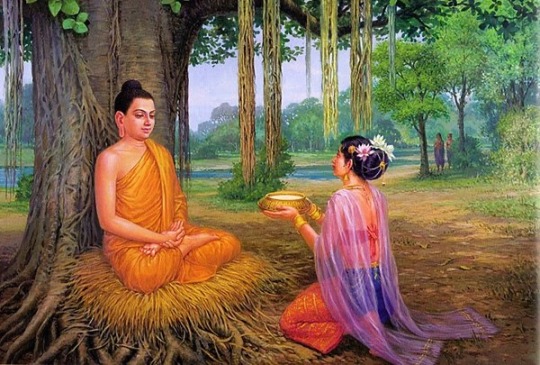
Ten Principal Disciples of Lord Buddha: Torchbearers of Dharma
The life of Siddhartha Gautama, the Buddha, is synonymous with the profound purpose of alleviating the suffering of all sentient beings. During his forty-five years of earthly existence, the Buddha encountered numerous individuals, and his transformative interactions inspired many to become his disciples. Among the multitude who embraced his teachings, ten disciples emerged as the principal torchbearers of Lord Buddha's dharma, carrying forth the essence of enlightenment far and wide.
1. **Sariputra (Upatissa):** Renowned as one of the two chief male disciples, Sariputra, also known as Upatissa, shared this eminent position with Moggallana. Born on the same day as Moggallana, Sariputra attained Nirvana and became an Arhat, celebrated for being "Foremost in Wisdom." His profound understanding earned him praise from the Buddha, and his wisdom became a guiding light for future generations.
2. **Moggallana (Maudgalyayana):** A close friend of Sariputra, Moggallana, also known as Maudgalyayana, stood as the other chief male disciple of Lord Buddha. Endowed with transcendental powers, Moggallana, depicted with a dark complexion, played a crucial role in aiding people through his psychic abilities. His passing, occurring two weeks after Sariputra's death, marked the end of an era.
3. **Mahakasyapa:** Revered for his ascetic practices, Mahakasyapa emerged as a key figure in the post-Buddha era. Following the Buddha's final nirvana, Mahakasyapa and 500 disciples compiled Buddha's Suttas, assuming leadership of the Sangha. As the "father of sangha," Mahakasyapa became the first to directly preach the teachings and sutras of the Buddha.
4. **Subhuti:** As one of the ten Great Disciples, Subhuti stood out for his deep understanding of the doctrine of emptiness. Mentioned in the Prajnaparamita of Mahayana Buddhism, Subhuti's prominence lay in grasping the profound concept of emptiness, contributing to the expansive tapestry of Buddhist thought.
5. **Purna Maitrayani-Putra:** Known for his enthusiastic preaching, Purna, also called Purna Maitrayani-Putra, dedicated himself to ensuring the future of Buddhism. While there is no evidence of his Nirvana, Purna's focus on spreading the seeds of Buddhism and serving the public underscored his commitment to the Buddha's teachings.
6. **Katyayana (Mahakatyayana):** Distinguished as foremost in spreading the Dharma, Katyayana played a pivotal role in disseminating the teachings of Lord Buddha. His profound understanding of Buddha's lectures positioned him as a key figure in the transmission of the Dharma.
7. **Anuradha:** A cousin of Shakyamuni Buddha, Anuradha, alongside Ananda, became a disciple of Lord Buddha. Renowned for his divine insight and mastery of clairvoyance, Anuradha's journey included a self-imposed vow not to sleep, leading to the loss of his sight. Later, he regained vision, believed to possess the power to perceive truth.
8. **Upali:** Originating from the lowest class of Indian society and working as a barber, Upali's journey to discipleship was marked by hesitancy. Foremost in observing precepts, Upali joined Lord Buddha when he was cutting his hair. Later, Upali's transformation led him to become an Arhat, chief disciple, and a key figure in the development of the Vinaya School.
9. **Rahula:** The only son of Shakyamuni Buddha before his enlightenment, Rahula became a monk at a young age. Achieving Enlightenment at 18, Rahula's early entry into monkhood and subsequent spiritual attainment marked him as one of the Ten Great Disciples.
10. **Ananda:** Renowned for his exceptional hearing of Buddha's teachings, Ananda, alongside Anuradha, was a cousin of Lord Buddha and became a disciple simultaneously. The term "Ananda" meaning "great delight" epitomized his role as the caretaker of Lord Buddha for 25 years, illustrating his unwavering dedication to preserving and disseminating the Buddha's words.
These Ten Principal Disciples of Lord Buddha, each excelling in distinct qualities, became pillars of Buddhism, ensuring the propagation of the dharma and the enlightenment path for generations to come.
16 notes
·
View notes
Text
@staff

Devi Katyayani is named after the sage Katyayana, who performed intense penance to be granted the boon of the Divine Mother taking birth as his daughter. She is often depicted as having four arms and riding a lion. She is associated with valor and courage and is known for her warrior-like form. Her image carries a sword, a lotus, a chakra (discus), and a kamandalu (a water pot).
2 notes
·
View notes
Text
Hello friends 👋
जय माँ नव दुर्गा 🌹
Today it is the sixth day of Navratri for this year.
It is the day of Maa Katyayani.
Maa Katyayani is the Goddess of Power and She is also the daughter of Sage Katyayana.
So everyone, let's enjoy today's Navratri and pray to our Maa for prosperity and Happiness ☺
जय माँ कात्यायनी
Here is a link to our latest upload
Happy Navratri to you all ☺
youtube
#navratri#devotional#navdurga#durga#navratri special#katyayani#hindufestival#hinduism#hindu gods#youtube
0 notes
Text
"The One Rule." From the Rudraksha Jabala Upanishad, the Exploration of the Mysteries of the Metronome.

In the next section, a group of sages ask Shiva about the rules for wearing the Hindu Rosary. There are several, but one alone is best:
The base of the Rudraksha bead is Brahma, its navel is Vishnu, its face is Rudra and its hole consists of all gods. One day Sanatkumara “the prince” asked Kalagnirudra “the fire at the end of time”: “O Lord! Tell me the rules for wearing Rudrakshas”.
At that time Nidagha (sweat), Jadabharata (a stupid man), Dattatreya (the three head lord of the world), Katyayana (the fit vehicle), Bharadvaja (the skylark), Kapila (brass), Vasishtha (revealer), Pippalada (given to pleasures), etc., came to Kalagnirudra. Then Lord Kalagnirudra asked them why they all had come in a group. They all answered that they came to hear the method of wearing Rudrakshas.
Kalagnirudra said: Those that are born out of Rudra’s Akshis (eyes) are called Rudrakshas. When these beads are even once touched by hand, one attains the glory of giving in charity two thousand cows at a time. When they are worn in ears, he gets the effect of giving out eleven thousand cows in charity. He also attains the state of the eleven Rudras.
When the beads are worn on the head, one has the benefit of giving a crore of cows in charity. Of all these places, I am unable to tell you the benefit when worn in the ears. Whoever studies this Rudraksha Jabala Upanishad, be he a boy or a youth, becomes great. He becomes the Guru of all and the teacher of all Mantras. Havan (the invocation) and Archana (the praise) should be done with these Mantras (of the Upanishad).
To give kindness to all persons as a set condition of the mind is the One Rule. This is the way a saint thinks and behaves. As the Sage says, even young children can be saints.
0 notes
Text
instagram
Katyayani is an aspect of Mahadevi and the slayer of the tyrannical demon Mahishasura. She is the sixth among the Navadurgas, the nine forms of Hindu goddess Durga who are worshipped during the festival of Navaratri. According to Hindu mythology, Goddess Shakti decided to take birth on Earth and end the reign of Mahishasura. She granted the wish of Sage Katyayana and was born on Earth as his daughter, Katyayani. Katyayani is depicted with four, ten or eighteen hands. She is one of the highly revered forms of Goddess Durga and is worshipped during Navratri. The following is a brief story of Katyayani: She killed Mahishasura and became Mahishasuramardini. Desiring to obtain Krishna as their husband, the gopis would then worship the goddess Kātyāyanī with incense, flowers and other items.
#NavratriDay6#GoddessKatyayani#DivineFeminine#Devotion#KatyayaniPuja#SpiritualJourney#FestivalVibes#PrayersAndBlessings#DivineGrace#HappinessInWorship#CelebrateNavratri#ED4WO#StudyAbroad#Instagram
0 notes
Text
Maa Katyayani : The Goddess of Six Day of Navratri

Maa Katyayani is one of the forms of the Hindu goddess Durga, who is worshipped during the Navratri festival in India. She is often depicted as a six-armed deity riding a lion and holding a lotus, sword, discus, bow, arrow, and a mace. Her name is derived from the name of Sage Katyayana, who is said to have worshipped her.
The story of Maa Katyayani goes back to the time when the demon Mahishasura had gained invincibility by a boon from Lord Brahma and was wreaking havoc in the three worlds. The gods were unable to defeat Mahishasura, and they turned to the goddess Parvati for help.
Parvati then underwent severe penance for several years to please Lord Brahma, who appeared before her and granted her a boon. Parvati requested that she be born as the daughter of Sage Katyayana and that she would destroy Mahishasura. Lord Brahma granted her wish, and Parvati was born as Katyayani.
Maa Katyayani grew up to be a beautiful and fierce warrior goddess, riding on a lion and wielding various weapons. She went to battle with Mahishasura and defeated him, restoring peace and order in the three worlds.
The importance of Maa Katyayani lies in the fact that she is believed to represent courage, strength, and determination. Devotees believe that worshipping Maa Katyayani can help them overcome obstacles and achieve their goals. She is also believed to bless her devotees with marital harmony and help unmarried women find suitable partners.
Maa Katyayani is also associated with the Manipura chakra, which is believed to be the centre of personal power and willpower. Devotees of Maa Katyayani believe that meditating on her can help them balance this chakra and gain inner strength and confidence.
Mantra:
क्लीं श्री त्रिनेत्रायै नम:।
OR
ॐ क्रीं कात्यायनी क्रीं नम:।
Book Puja At Home, Book Daily Puja & Mantra Japa at Home
0 notes
Text
Embracing Goddess Katyayani on the Sixth Day of Navratri
Navratri, the nine-night festival cherished throughout India, embodies high spirits, religious devotion, and cultural richness. Among these auspicious days, the sixth day, observed in honor of Goddess Katyayani, is exceptionally significant.

Born out of the fervent prayers of Sage Katyayana, Goddess Katyayani is revered as a symbol of divine strength and courage. Her aura inspires fearlessness to combat darkness and instills hope for success and prosperity in the hearts of the devoted.
On this notable day, the idols of Goddess Katyayani are beautifully adorned in vivid red, demonstrating her immense power and valor. Devotees seek her divine blessings through the offering of honey, symbolizing sweetness, health, and wealth.
The sixth day of Navratri is marked with religious hymns, spirited mantras, and vibrant 'Garba' performances that captivate every heart, echoing unity within the diversity. Furthermore, the faithful devotees observe a day-long fast, a spiritual practice of self-discipline, culminating in the distribution of 'prasadam,' a token of divine grace spreading the flavors of joyous festivity.
Worshipping Goddess Katyayani molds the path towards overcoming adversities and achieving success, love, and prosperity. As an embodiment of bravery and determination, she highlights the essence of power and courage, illuminating lives with the light of fearlessness.
As we embark on the celebration of the sixth day of Navratri, let's imbue our spirits with Goddess Katyayani's divine blessings. With her benevolence steering our life's course, we can strive to overcome obstacles, reach new heights, and radiate positivity.
Through chants and prayers, we seek Goddess Katyayani's divine guidance, harnessing her spiritual strength. Let her empowering aura guide us towards a fulfilling journey, filled with courage, health, prosperity, and an undying spirit of resilience. May her divine blessings be with us always. Happy Navratri!
0 notes
Photo
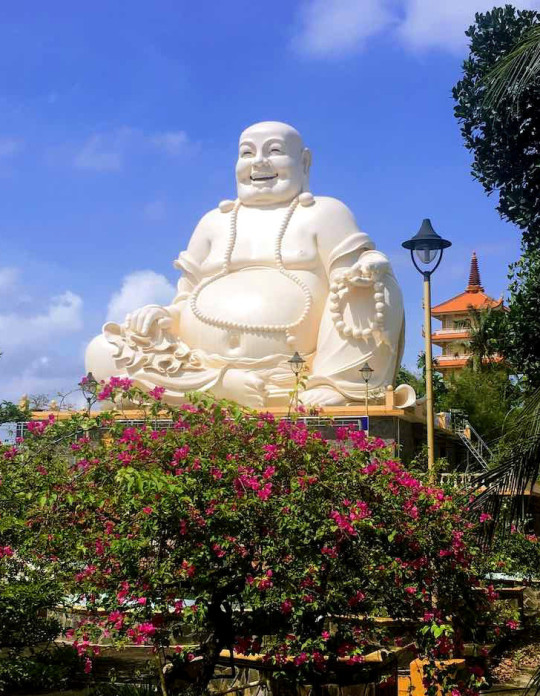
The Quest for Buddhism (59)
Early Buddhism and the disciples
Ten Principal Disciples No. 6: Katyayana or Mahakatyayana - foremost in commentary
Katyayana is listed as one of the 10 principal disciples (Ref) and was capable of expanding on, and those presenting the detailed meaning of what is spoken in brief of the Buddha. He is also called Mahakatyayana with the addition of Mahā (meaning 'great'). His name differs markedly in scriptures and other notations.
In Thai Buddhism, he is also known as Phra Sangkajai (Chinese Budai, Japanese Hotei) and often portrayed as extremely portly. Perhaps this is where the image of the fat smiling Buddha on piggy banks and figurines began.
In the Pali tradition, Katyayana was born as Nalaka, born of a brahmin family in the city of Ujjayini (modern-day Ujjain). His father was a brahmin advisor to King Candapajjota, ruler of the state of Avanti. His name is explained by the golden hue of his skin (his parents called him Kancanamanava, meaning the 'young man with golden colored skin'), and the name of the gotra. He received a classical brahmin education, which included study of the Vedas.
After his father died, Katyayana became an advisor to the same king. At the king's request, Katyayana left with a group of seven friends to visit the Buddha to invite him to come to Avanti. The eight gained enlightenment while listening to him preach, and were ordained by the Buddha. As a monk, Katyayana became known by his gotra name (‘gotra’ is the general name for Brahmin clans in India).
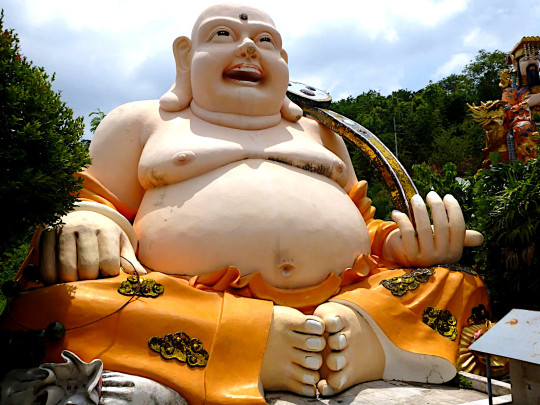
仏教の探求 (59)
初期仏教と弟子たち
十大弟子その六: 迦旃延、又は摩訶迦旃延 (まかかせんねん、梵: マハーカーティヤーヤナ) 〜論議第一
迦旃延 (かせんねん)は十大弟子(参照)の一人であ��、釈迦が簡潔に語ったこ���を詳しく説明し、その意味を広く伝えることができたとされている。摩訶 (まか、梵: マハー: 偉大なるの意)を加えて摩訶迦旃延 (まかかせんねん)、又は大迦旃延 (だいかせんねん)などとも呼ばれる。彼の名前は、経典などにより表記が著しく異なる。
タイ仏教では、プラ・サンカジャイ (中国のブダイ、日本の布袋)とも呼ばれ、非常に太った姿で描かれることが多い。貯金箱や置物の太った笑顔のブッダのイメージはここから始まったのかもしれません。
パーリ語の伝承では、カーティヤーヤナはウジャイニー(現在のウジャイン) の都のバラモンの家にナーラカとして生まれたとされている。父はアヴァンティ国の支配者であるカンダパジョータ王の顧問を務めるバラモンであった。彼の名前は、彼の肌が金色であること (両親は彼を「黄金色の肌を持つ若者」という意味のカニャンカナマーナヴァと呼んだ)、およびゴートラの名前から説明される。彼は、ヴェーダを学ぶなど、古典的なバラモン教の教育を受けた。
父の死後、カーティヤーヤナは同じ王の顧問となった。王の要請により、カーティヤーヤナは7人の友人たちを連れて、アヴァンティに来るようにとブッダを訪ねた。8人は彼の説法を聞いているうちに悟りを開き、ブッダのもとで出家した。僧侶となったカーティヤーヤナは、ゴートラ名で呼ばれるようになった (‘ゴートラ’とは、インドのバラモン階級の氏族の総称)。
#katyayana#mahakatyayana#10 principle desciples#buddha#buddhism#foremost in commentary#budai#hotei#smiling buddha#gotra#history#philosophy#nature#art#golden coloured#good luck
84 notes
·
View notes
Note
Since Navratri has started can you please talk about all forms of Durga?
mmkay sure
first up : the navaratri calendar - which makes zero sense. since hinduism follows the lunar calendar, sometimes you end up with two navaratris on the same damn day, which is why the navaratri this time is 8 days instead of 9.
secondly, like i keep saying over here, you cannot consume onion, garlic, eggs and non veg until after Dussehra, which is a bummer
thirdly, in my house, we establish an akhand jyoti and a pot full of barley. the akhand jyoti, as the name suggests, has to be lit 24X7 until Dussehra is over, and has to be continuously fed and taken care of - once lit, it cannot be extinguished. the barley we sow on day one, it's saplings are used in the Dussehra pooja in my house.
so now onto the ladies :D
Prathamaa : Shailaputri - Daughter of the Mountains, this form of the goddess celebrates her as Sati Bhawani or Uma, when she was still a girl and unmarried.
Dwitiyaa : Brahmacharini - The Celibate, this form of the goddess celebrates her knowledge seeking and withdrawn form. Parvati had taken this form when she underwent severe penance to please Shiva and win his heart, and this form is also known as Aparna (she who forsook leaves, for parvati didn't consume anything during her tapas).
Tritiyaa : Chandraghanta - The Goddess with the Moonbell, this form of the goddess celebrates her royalty and bravery. A crescent moon lies on her forehead, or she wears earrings resembling the moon, thus her name. She is the first goddess who appears with ten hands, wielding weapons and riding a lion.
Chaturthi : Kushmanda - The Cosmic Egg, this form of the goddess celebrates her primordial form. It is said that Kushmanda created the entire universe just by a small smile. Yogamaya is another one of her forms.
Panchami : Skandamata - Mother of Skanda, this form of the goddess celebrates her motherly nature, and her affection towards children. She is shown as holding her infant son Skanda (also known as Kartikeya, the god of war) and wielding weapons, symbolising her protectiveness. In some depictions, she simply holds a lotus, symbolising her gentleness.
Shashti : Katyayini - Daughter of Katyayana, this form of the goddess is the most fierce. She was born of Sage Katyayana, hence the name. This is the first form the goddess took while fighting Mahishasura.
Saptami : Kaalaratri - She Who is Dark as Night, this form of the goddess is quite similar to Goddess Kali, in both character and depiction, the only difference being is that she rides a donkey while Kali rites a ghost. She is gentler than Kali, scaring away and protecting us from negative energies.
Ashtami : Mahagauri - Gauri the Great, this form celebrates Goddess Gauri as Lord Shiva's wife. She grants knowledge and wisdom to everybody. Unmarried women worship her for a suitable partner, while married women worship her to maintain marital bliss. Teej, a big festival here in North India and Rajasthan, is her own festival.
Navami : Siddhidatri - She Who Grants Power (Siddhis), Siddhidatri is the goddess' ultimate magnificent form. She bears the fruit of all the devotion and rituals during the course of these nine days, and grants the devotee whatever their heart desires.
In North India, in certain families, Navaratri ends on the seventh or eighth day only (in my family it's the eighth day). Whichever day you conclude the festival, we invite nine girls to our house and feed and worship them. The holy prasad served to the goddess that day is first given to them, untouched except for being served. Then the youngest one is given a chunari (a red, filigreed scarf which was used in the rituals), while all the girls receive gifts and money, and the hosts (ie my parents) touch all of their feet. This practice is called Kanjak. Sometimes, a boy is also invited who represents the "langur", or the monkey which guards the temples of goddesses in North India.
During this course, Ramleelas are staged parallely, which depict the entirety of Tulsidas' Ramayana, at night during stage plays and big carnivals in North India. On the tenth day, while Bengalis and South Indians submerge the goddess' idol and celebrate her victory over Mahishasura, North Indians instead celebrate Ram's victory over Ravana which is symbolised at the end of the Ramleela - the actor who plays Rama burns the giant effigies of Ravana, his brother Kumbhakarna, and his son Indrajit, by shooting flaming arrows at them.
187 notes
·
View notes
Photo

Katyayana (Kasennen), from the series "Two Bodhisattva and Ten Great Disciples of Sakyamuni (Nibosatsu Shaka judai deshi)", Munakata Shikô, 1955, Art Institute of Chicago: Asian Art
Gift of Oliver Statler Medium: Woodblock print
https://www.artic.edu/artworks/15862/
8 notes
·
View notes
Text
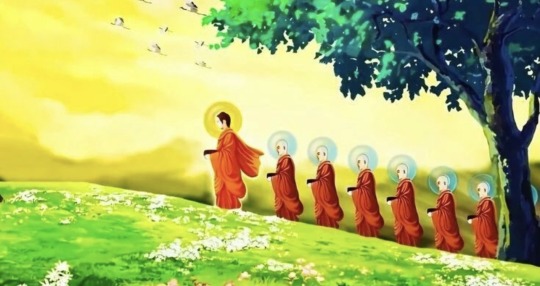
Buddha & His Chef disciples
There are 10 Great Disciples of Lord Buddha who had carried his teachings, dharma, and had spread Buddhism far wide. They are Sariputra, Moggallana, Mahakasyapa, Subhuti, Purna, Katyayana, Anuradha, Upali, Rahula and Ananda.
The life of Buddha has always been for the purpose of helping all sentient beings to make them free from suffering and pain of the life. During the lifetime of Buddha, he countered numerous people and his encounter with those people has transformed many people and followed him since then. During his forty-five years of life time, many became his disciples but there are Ten Principal
Disciples of Lord Buddha who carried on his teachings, his dharma and spread Buddhism far wider. Each disciple were known for a specific quality or area and being a foremost among all the Buddha's disciples.
#buddha#buddhist#buddhism#dharma#sangha#mahayana#zen#milarepa#tibetan buddhism#thich nhat hanh#dhammapada#karma#mindfulness#dakini#four noble truths#pure land#equanimity#avalokitesvara#enlightenedconsciousness#manjushri#tsongkhapa#enlightenment spiritualawakening reincarnation tibetan siddhi yoga naga buddha#right view#impermanence#padmasambhava#heart sutra#bodhisattva#medicine buddha#meditation
13 notes
·
View notes
Photo
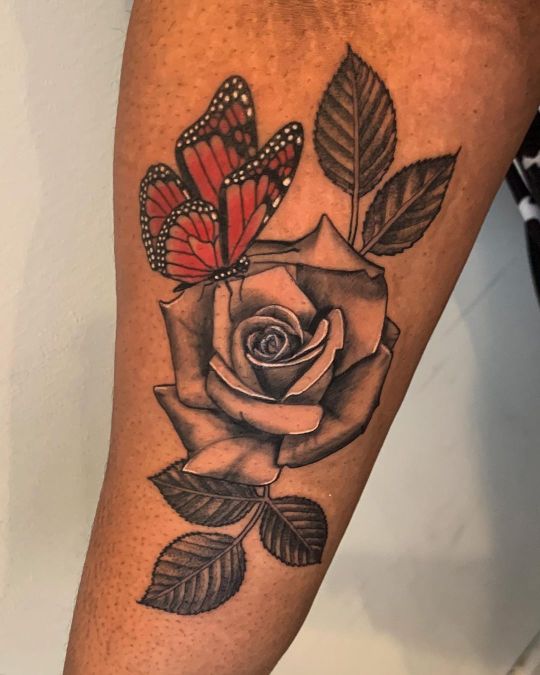
🌹🦋 thank you Katyayana . . . #rosetattoo #butterflytattoo #realismtattoo #blackandgreyrose #brooklyntattoo #nyctattoo #bushwicktattoo #blackandgrey #redbutterfly (at Bushwick) https://www.instagram.com/p/CQrVoShr28P/?utm_medium=tumblr
#rosetattoo#butterflytattoo#realismtattoo#blackandgreyrose#brooklyntattoo#nyctattoo#bushwicktattoo#blackandgrey#redbutterfly
1 note
·
View note
Text

Sri MAtre Namah
Significance of NavadurgA Devi by Sri KAmakoti Mandali
1. shailaputrI – Daughter of the Mountain King – himavAn. Even though parAmbA is paramaishvaryashAlinI and jaganmAtA, she accepted to become the daughter of himavanta and the sole reason behind this was her bhaktavAtsalya. By remembering her form as shailaputrI, the intent of the upAsaka is to make himself worthy of the limitless vAtsalya of parAmbA.
2. brahmachAriNI – The one whose contemplation grants brahmasvarUpa is called brahmachAriNI. parAmbA is invoked as brahmachAriNI to attain brahmavidyA. This explanation would especially suit in the context of skandayamaLa which describes brahmachAriNI as the consort of jnAna-shiva.
3. chandraghaNTA – parAmbA is known so on account of holding in her hand a ghaNTA that is bright like the moon. It can also mean the one whose speech puts Chandra to shame in terms of beauty and AhlAda [AhlAdakAriNI devI chandraghaNTeti kIrtitA]. It is also interpreted to refer to parAmbA as the one whose lAvaNya puts Chandra to shame. Invoking ambA in this form grants one manollAsa. The phala of invoking chandraghaNTA is easily understood by observing her mantra.
4. kUShmANDA – The one who swallows the aNDa named samsAra that is filled with trividha santApa is named kUShmANDA. By meditating on this form, one is blessed with bhUmilAbha and duHkhanivrtti.
5. skandamAtA – skanda was originally sanatkumAra the greatest of brahma-jnAnis. Even such a jnAni chose to be born as skanda or ShaNmukha to attain the saubhAgya of having parAmbA as his mother. She, whose glory surpasses every known peak, be it in the realm of jnAna, bhakti or karma, is skandamAtA. This also indicates that only the jnAnis approach parAmbA to attain paripakvata and not the less fortunate.
6. kAtyAyanI – The one who appeared in the hermitage of kAtyAyana and was accepted as his daughter, is known as kAtyAyanI. She is forever kumarI and this form makes two important statements. One is her svAtantrya indicated by the lack of patyadhInatA and the second is indicative of her svarUpa which is beyond shiva and shakti or puruSha and prakRti. We have discussed elsewhere the incorrectness of assuming the equality between shakti of the shAktas and the prakrti of the sAmkhyan thought.
7. kAlarAtrikA – kAla or yama is the destroyer of all beings. At mahApralaya, even he attains laya within the rAtri named kAlarAtri and this indicates her kAlAtItasvarUpa. According to uttara kaula tantras, mahAkAla attains antarbhAva or mahArati within kAlikA during tattva-pralaya and it is kAlikA alone who remains, at which point she is called kAlarAtri or kAlasamkarShiNI. The shakti tattva here is encompassing or transcending the shiva tattva.
8. mahAgaurI – mahAgaurI indicates the transformation of kAlasamkarShiNI to kAmeshvarI or gaurI where she creates a pati for herself by attaining aruNa varNa and accepts patyadhInatA for the sake of samsAra srShTi, assuming gauravarNa.
9. siddhidAtrI – The one grants various kinds of Siddhis including mokSha to upAsakas based on their qualification.
One can refer to commentaries such as guptavatI for other generic interpretations. The navadurgA-s are also samketas for the letters of navArNa mantra, and their significance can also be grasped from the vyaShTi and samaShTi arthas of navArNa mantra discussed in brhadvArAhI tantra. By understanding the tattva conveyed by these nine forms where each form represents a peculiar transformation of parAmbA, one can also gather why praNava is not added before navAkSharI mantra.
Have a blessed Sharadha NavarAtri.
25 notes
·
View notes
Photo

#katyayana #buddhist (at บุญ ตง กี่ เซ็นทรัล อีสวิล เรียบด่วน) https://www.instagram.com/p/Bo6ivPtFCtB/?utm_source=ig_tumblr_share&igshid=103gqyrj7s8l4
0 notes